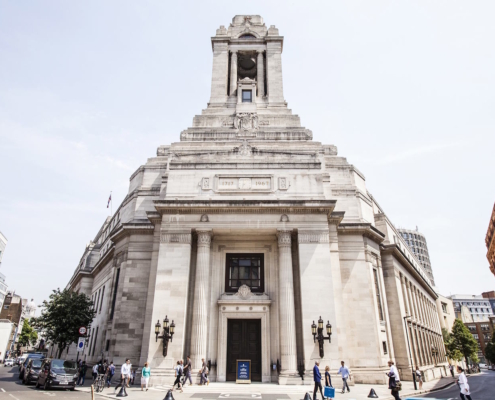A design by architects HV Ashley and F Winton Newman was chosen and building work started in 1927. Construction began at the western corner of the new building, where houses on Great Queen Street had been demolished, and progressed eastwards.
The new Masonic Peace Memorial, as it was called, was dedicated on 19 July 1933. The theme of the memorial window outside the Grand Temple was the attainment of peace through sacrifice. Its main feature was the figure of peace holding a model of the tower façade of the building. In the lower panels were shown fighting men, civilians and pilgrims ascending a winding staircase towards the angel of peace.
In June 1938, the Building Committee announced that a memorial shrine, to be designed by Walter Gilbert, would be placed under the memorial window. Its symbols portrayed peace and the attainment of eternal life. It took the form of a bronze casket resting on an ark among reeds, the boat indicative of a journey that had come to an end. In the centre of the front panel a relief showed the hand of God in which rested the soul of man. At the four corners stood pairs of winged seraphim with golden trumpets and across its front were gilded figures of Moses, Joshua, Solomon and St George.
In December 1914 Grand Lodge had begun to compile a Roll of Honour of all members who had died in the war. In June 1921, the roll was declared complete, listing 3,078 names, and was printed in book form. After completion of the Memorial Shrine, the Roll of Honour, with the addition of over 350 names, was displayed within it on a parchment roll.
The Roll of Honour is guarded by kneeling figures representing the four fighting services (Royal Navy, Royal Marines, Army and Royal Flying Corps). By the time all these memorials were complete, the country was already in the midst of another war.
Freemasons’ Hall, as it is now known, continued to operate during that Second World War and survived largely undamaged.
Members of the public and of course Freemasons are welcome to visit Freemasons’ Hall. The Hall regularly takes part in ‘open house’ initiatives.


